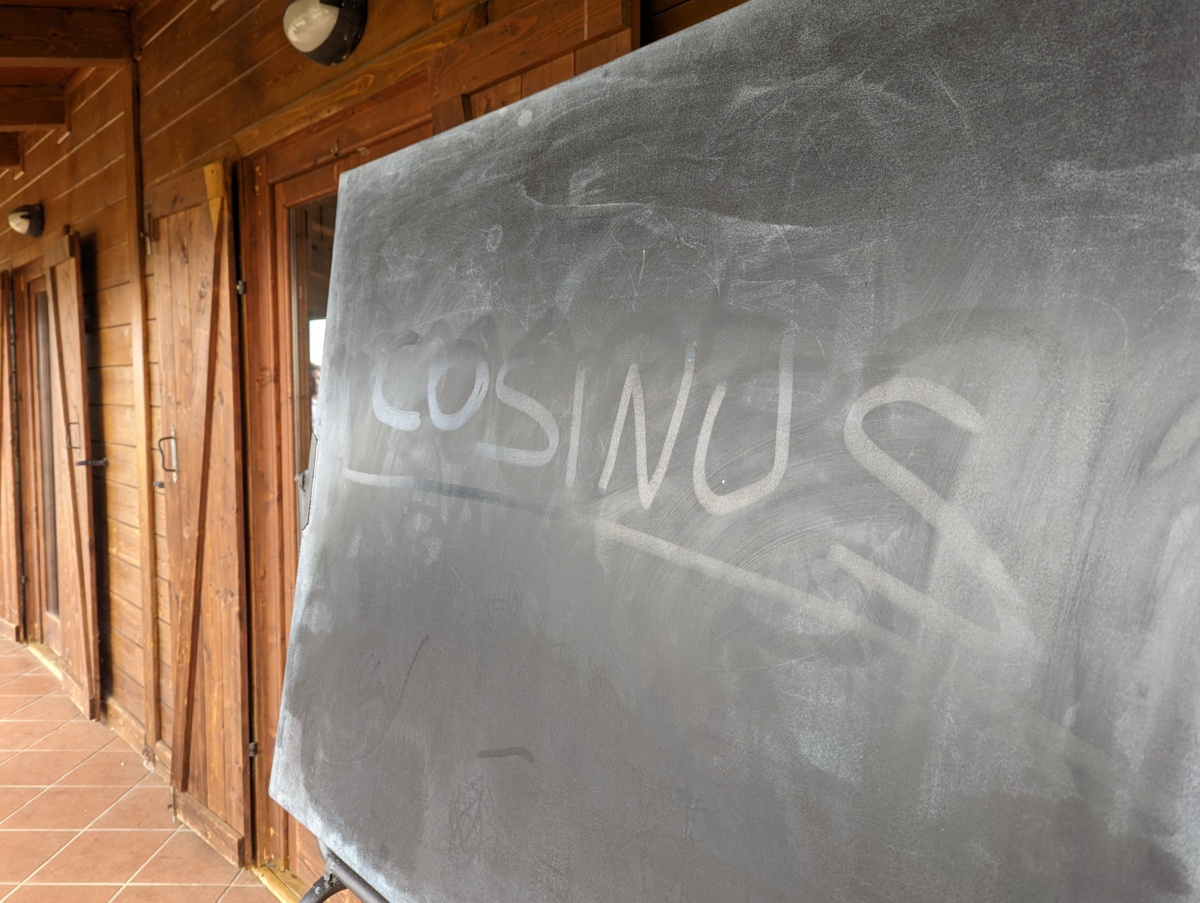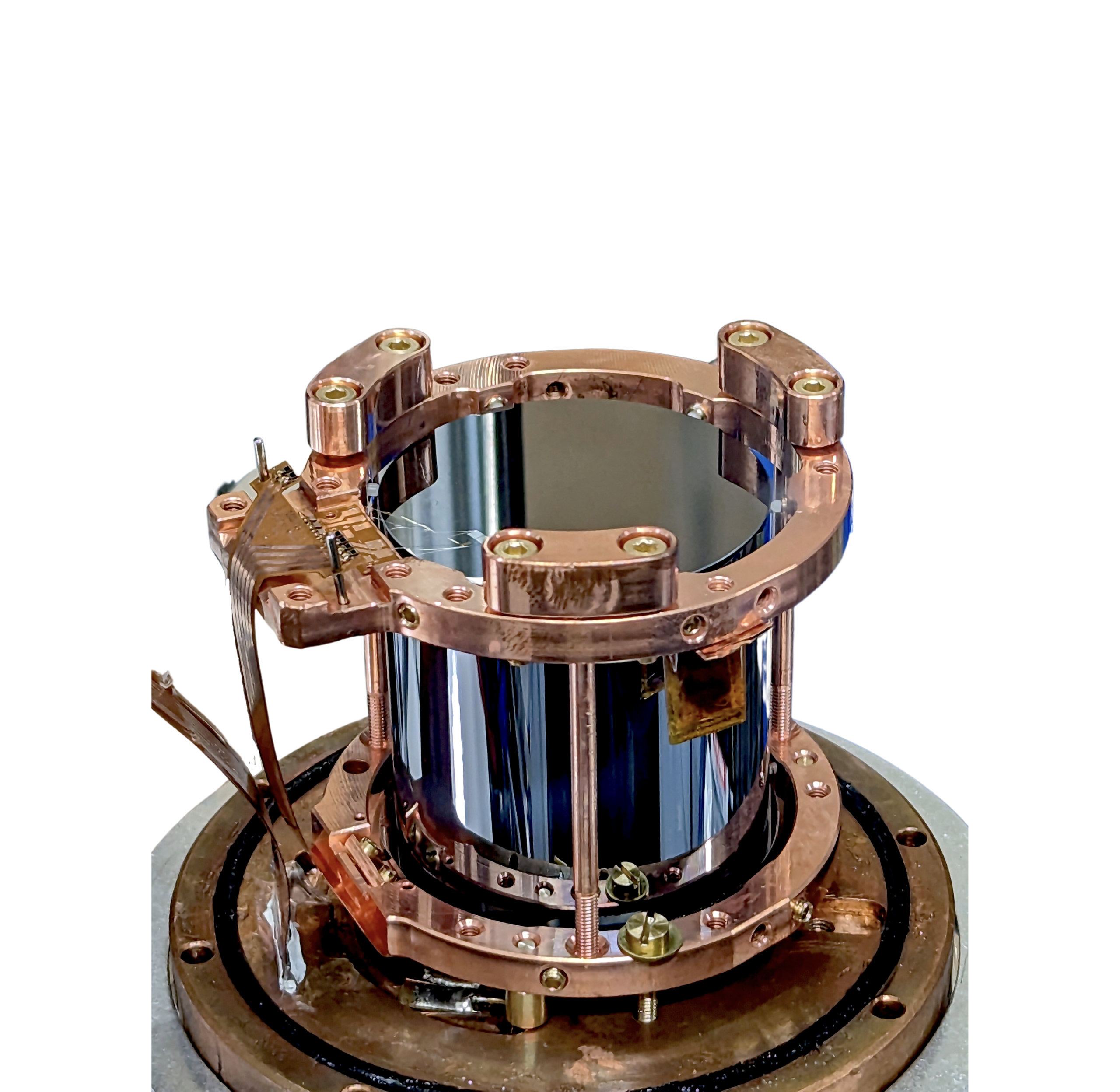How does a COSINUS detector work?
COSINUS utilizes cryogenic scintillating calorimeters operated at around ten milli-Kelvin using undoped sodium iodide (NaI) crystals as target. As both, DAMA/LIBRA and COSINUS use a NaI target, their experimental results can be directly compared without assuming a specific dark matter model. For the analysis of data, the only required choice is whether dark matter is expected to interact with nuclei or electrons. COSINUS is searching for nuclear interactions. COSINUS detection technique is unique in the family of NaI-based dark matter searches, offering significantly more sensitive devices and higher background rejection power.
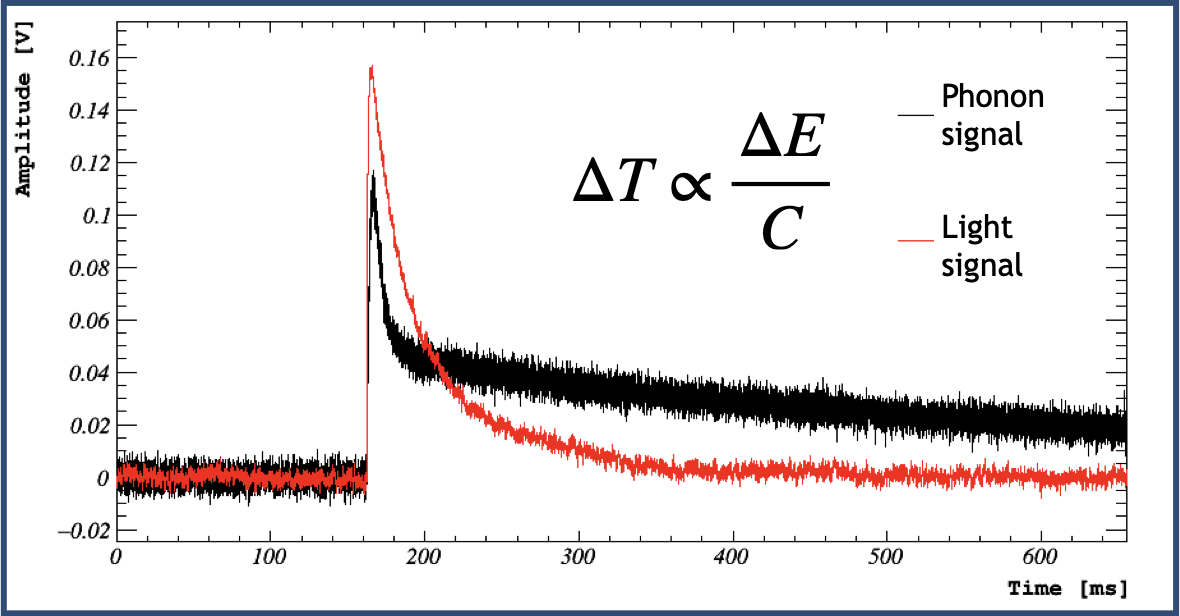
Calorimeters are instruments designed to measure the total energy deposited in a target. They are considered scintillating when the chosen target material emits mono-energetic photons (scintillation) when stimulated with incoming radiation. These devices are described as cryogenic due to their reliance on temperature sensors that operate at millikelvin levels for data readout. In a cryogenic scintillating calorimeter two signals are detected: the phonon signal (heat signal) and the scintillation light signal. While the phonon signal precisely measures the energy deposited in the crystal by the particle interaction, the light signal provides particle discrimination, as the amount of scintillation light produced strongly depends on the particle type. Particle discrimination allows us to separate potential signal events (nuclear recoils) from common backgrounds (beta/gammas) – a crucial advantage for any rare event search. Furthermore, the possibility to even discriminate nuclear recoils off Na and I in a COSINUS detector is a very powerful tool to study rare-processes on target nuclei.
The phonon signal, originating from lattice vibrations triggered by particle scatterings, is detected through a temperature sensor attached to the absorber. It consists of lattice vibrations induced by particle scatterings. NaI is a delicate material and the standard and established fabrication process of the temperature sensor on its surface is technologically challenging. Hence, COSINUS implemented a novel readout system, dubbed remoTES and successfully demonstrated its operation, initially on different crystals [1] with follow-up tests on NaI yielding promising results [2].
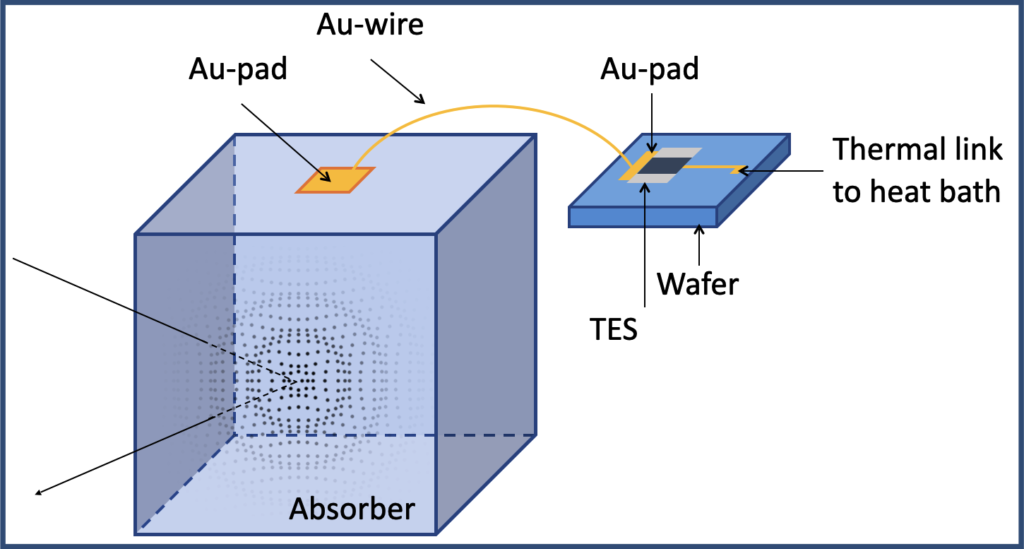
The light channel is similarly equipped with a Transition Edge Sensor (TES) for its readout mechanism. Specifically, a silicon (Si) beaker, which encases the NaI crystal, is outfitted with a conventional tungsten-based (W-based) TES readout system. This setup allows for the precise detection and analysis of scintillation light, enhancing the detector’s ability to identify and differentiate between various types of particle interactions.
The remoTES design scheme has been further adapted for the COSINUS detector. In this configuration, the NaI crystal is affixed to a thin silicon (Si) lid, with the remoTES linked to the NaI via a gold wire that passes through a hole in the lid. This lid, along with a beaker-shaped Si absorber, fully encases the NaI crystal, ensuring efficient scintillation light collection. This arrangement forms a completely active enclosure around the target crystal, enabling the effective vetoing of any alpha-related background noise. Such alpha-induced nuclear recoils are critical to address, as they can produce signals similar to those expected from dark matter interactions.
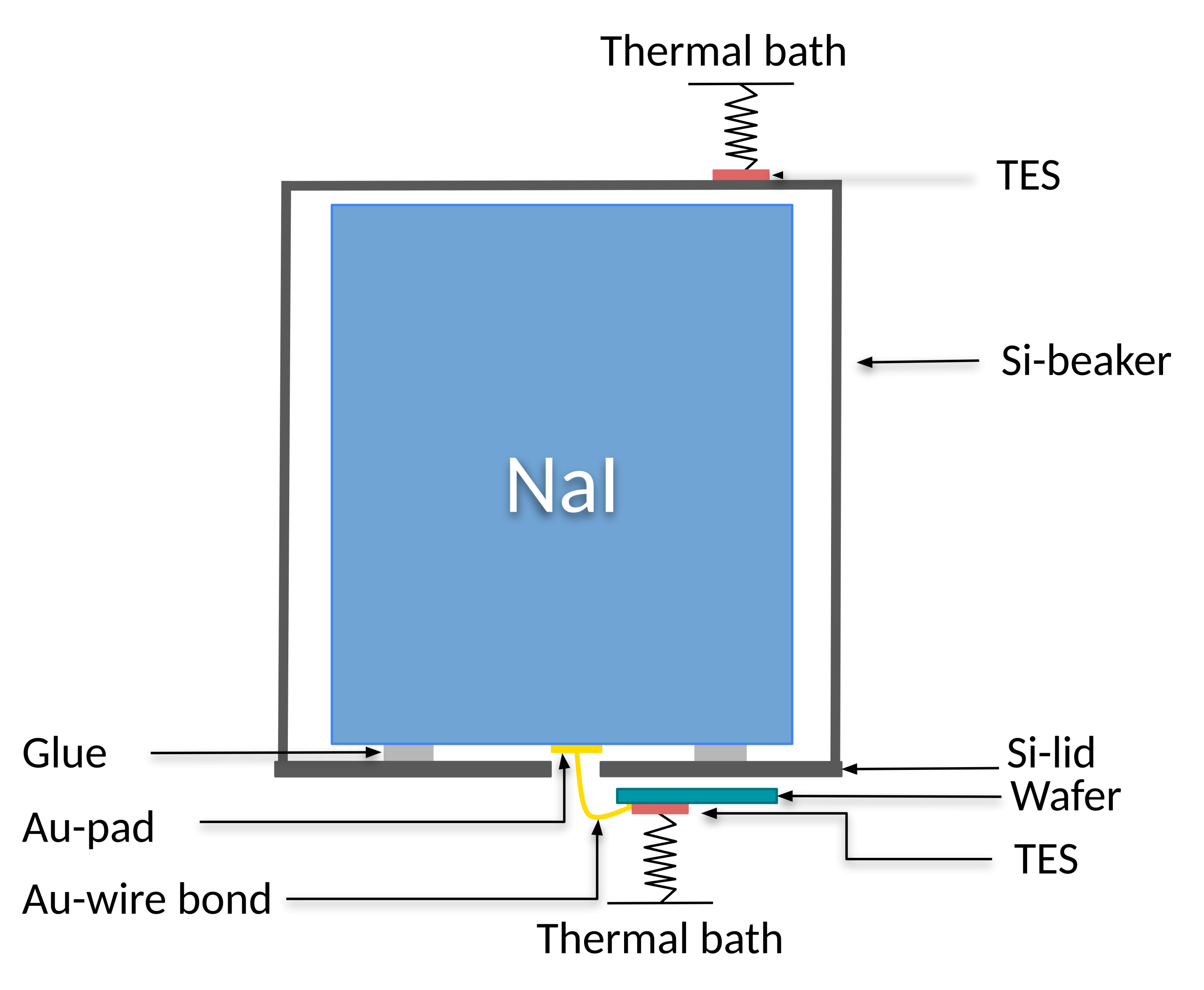
What we aim for?
In order to arrive at a comparable sensitivity to DAMA/LIBRA we aim for an energy resolution of the NaI calorimeter of 0.2 keV, corresponding to an energy threshold of 1 keV, independent of the interacting particle.
The depicted simulation showcases data that could be gathered with a target mass and exposure time of 100 kg days, equivalent to operating eight cubic NaI crystals, each about 2 cm on a side, for a year. This simulation assumes a COSINUS detector achieving a performance goal with an energy threshold of 1 keV and a conservative measured scintillation yield of 4%, although the best COSINUS detector to date has reached 13.1%. Data points are represented in the “light yield vs. energy” plane, where light yield is the ratio of light to phonon signal, normalized to unity for beta/gamma interactions. Black dots illustrate events from a uniform electron/gamma background of 1c/(keV kg day) and a 40K contamination with an activity of 600 μBq, akin to the DAMA/LIBRA background. Horizontal bands indicate the anticipated distribution of three event types: electron/gamma events in black, scatterings off sodium (Na) in blue, and iodine (I) in green, with 40K contributions appearing as a distinct line at about 3 keV within the electron/gamma band. Red events denote the influence of a theoretical dark matter particle with a mass of 10 GeV/c^2 and an interaction cross-section of 0.0002 pb, aligning with the DAMA/LIBRA modulation signal interpretation by Savage et al [4].
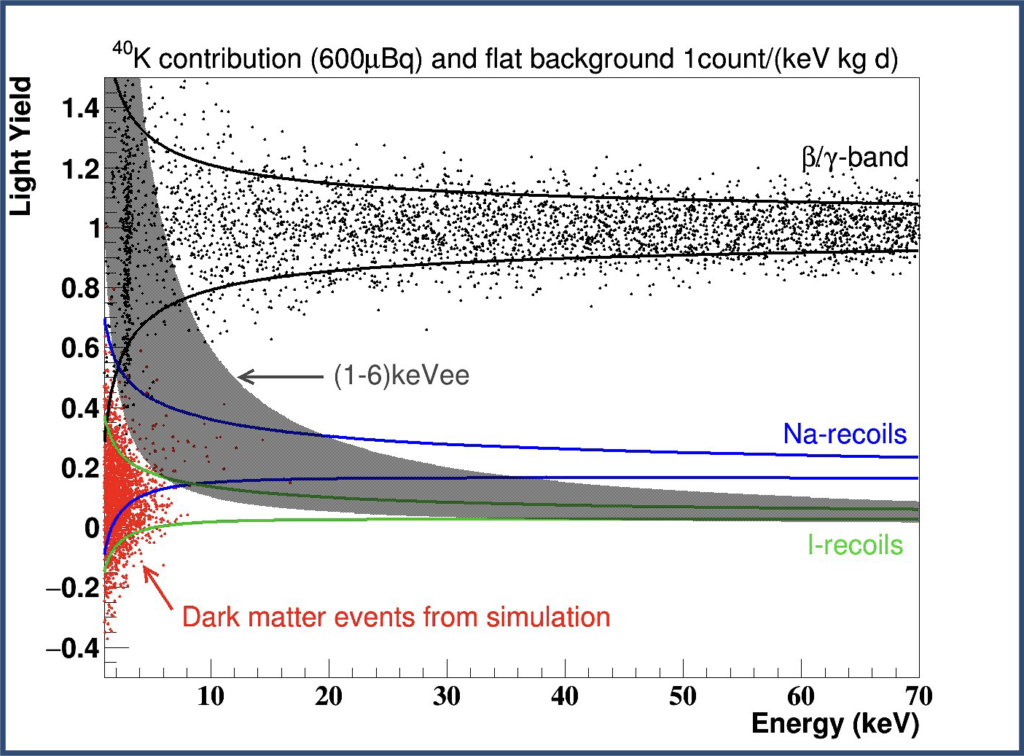
Red events within the grey shaded area correspond to those contributing to the DAMA/LIBRA modulation signal in the energy range of 2-6 keVee (electron equivalent), with black dots in the same area representing DAMA/LIBRA’s electron/gamma background.
The COSINUS project’s primary advantage lies in its low-energy threshold for nuclear recoils, a key feature of its cryogenic calorimeter detection technique. This capability is crucial due to the expected dark matter recoil spectrum’s exponential increase at lower energies. Moreover, COSINUS stands out among NaI-based detectors for its ability to identify particles on an event-by-event basis. This unique feature enables the precise identification of target-specific particle interactions, significantly enhancing the ability to suppress background noise.
In case the interaction observed by DAMA/LIBRA is on the electrons of the NaI target, only the excellent energy resolution and energy threshold remains while the benefit of particle-identification fades away as the signal is to be searched for in the electron/gamma-band. Since electron recoils are the dominant background in such detectors, low radioactive contaminations in the NaI crystals and a dedicated detector design will play the key role to enhance experimental sensitivity.
COSINUS first phase, (COSINUS- 1π), anticipated to start in 2025, with already a small number of detector modules (24 in total), operated in a low-background environment and simply counting the number of recoil events, will shed light on the nature of the DAMA/LIBRA’s modulation signal: Is it nuclear recoils or not? If something interesting hides around the corner, COSINUS will undertake a modulation signal search, in an upgraded phase (COSINUS- 2π) operating a small array of detectors for multi annual cycles.
References:
[1] G. Angloher et al., First measurements of remoTES cryogenic calorimeters: Easy-to-fabricate particle detectors for a wide choice of target materials, Nucl. Instrum. Methods: A, 1045, 167532 (2023)
[2] G. Angloher et al., Deep underground dark matter search with a COSINUS detector prototype, arxiv:2307.11139 (2023)
[3] R. Bernabei et al., The DAMA/LIBRA Apparatus, NIM A 592, 297 (2008)
[4] C. Savage et al., Compatibility of DAMA/LIBRA dark matter detection with other searches, J. of Cosmol. and Astropart. Phys. 2009, 560 010 (2009)

